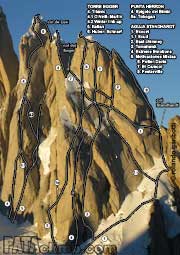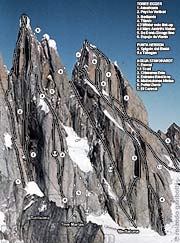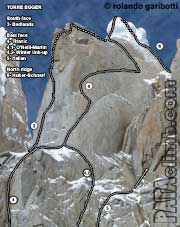Torre Egger – East face
5. De Doná-Giongo line
Bruno De Donà and Giuliano Giongo (Italy) claim to have climbed this route in March of 1980.
De Dona and Giongo's supposed line follows a line of weakness left of the massive serac, to then supposedly follow corners that lead to the col de Lux (Egger-Herron), and up Egger’s north ridge to the top. They made many attempts, including one the previous year with Cesare De Nardinis, during which they reached a point 250 meters shy of the top. They claim to have completed the route in four days from their snowcave at the base of the peak, utilizing but one single fixed rope. While descending in an epic storm they claim to have climbed Punta Herron, explaining that they had hoped to descend its north ridge, which they thought would be safer than their own route, but in the end they claim to have descended their own route. It should be noted that Herron involves more than 60 meters of vertical gain from the col, with hard mix climbing and a mushroom.
In an article about the climb in the Italian journal Scandere, Giongo makes statements about the use of fixed ropes that for the time –and sadly even today in many cases- were very progressive. In one passage he writes: “When in the Alps someone dares to equip and fix a route before completing the ascent, like the Spanish have done on the North face of Lavaredo, they are criticized without pity and the route gets degraded quickly; while, who knows why, even strong alpinists, when they are ten or twenty thousand kilometers from their homes, they feel authorized to use all the means with in their reach, even on mountains of moderate difficulty.”
Some in the Italian press called De Dona and Giongo’s the first “proper” ascent of Torre Egger, claiming that the American team had climbed 70% of their route up the East Face of Cerro Torre, having supposedly repeated Maestri’s line to the Egger-Torre col. Not only that judgment is way off base, but now that there are serious doubts about the veracity of De Dona and Giongo’s ascent, it is even more preposterous.
This line saw many previous attempts including one by a large Anglo-American team in 1974, Dan Reid and Rick Silvester (USA), Martin Boysen, Leo Dickinson, Don Whillans, Mick Coffey, Keith Lewis, Eric Jones, and Paul Braithwaite (UK). They reached a high point some 800 meters up, but were forced to retreat due to very warm weather that produced melting on the ice mushroom and therefore continuous bombardment by ice blocks. Ironically good weather is not always ideal.
It was also attempted by an expedition from New Zealand in late 1975 and early 1976. During this expedition Philip Herron lost his life when he fell into a crevasse near the base of the wall. This expedition also included Bill Denz, who returned in 1980 to attempt Cerro Torre solo, coming very close to his goal on two occasions. Other attempts include an Italian expedition led by Aldo Gross and composed of 16 guides from “Val di Fassa” in December 1976.
Doubts. Although there had been doubts about the veracity of De Doná and Giongo's account for quite sometime, because of their rather farfetched descent description that supposedly involved an ascent of Punta Herron, the can of worms was only properly opened in 2005, when German climber Thomas Huber stated publicly that he did not believe De Dona and Giongo's story. In the upper 200 meters De Dona and Giongo claim to have followed the north ridge, a mostly blank slab with discontinuous flakes and cracks that steepens significantly to the East (left) and drops off into the abyss of the Icecap to the West (right) leaving only one obvious line of weakness. Huber was the first to “repeat” that portion in 2005, while traversing from Herron (see Huber-Schnarf route). In the three mostly blank pitches he found no pitons, pin scars or bolts, or any other trace of passage, including no trace of passage at the col itself. About this section Giongo writes: “In the slabs below the summit mushroom we placed three bolts, as irrefutable proof of our passage”. Since Huber, five other parties have climbed through that section, Italians, Americans, Canadians and Argentines, and they also failed to find any trace of passage. The terrain is blank enough and smooth enough that even a single piton 50 or more meters to the side would not go unnoticed.
In Giongo's article in Scandere it is possible to see photos of the first ascentionists climbing and on top of a mushroom like formation, in the middle of a storm with no background scenery. Is it possible that they climbed Herron and not Egger? There is no trace of passage on Herron either, or at the col, but the terrain on both is the kind of terrain where traces of passage are much more likely to go unnoticed than in the north ridge of Egger.
Huber went on to christen the col between Egger and Herron "col de Lux", explaining “because we think we were the first humans on this col; we found no trace of the Italians here or anyplace above.”
Attempts to get further clarification, via mail (to Giongo and De Dona, two letters to each) and phone (to Giongo) in 1999 went unanswered.
Approach. Niponino to Noruegos to Glaciar Torre Superior.
Descent. BASE jump down the south face, Badlands, or rappel down Titanic.
Bibliography.
De Dona. Rivista della Montagna 43 p. 52; Scandere 1980 p. 22-37; AAJ 1981 p. 239; CAI-Rivista Mensile 1981/5-6 p.198-205; Berg 1984 p. 142-157; Alp magazine 184 p. 62-70.
Reid et al. Mountain magazine37 p. 11; Mountain magazine 38 p. 30; AAJ 1975 p.184-188.
Herron et al. NZ AJ 1977 p. 62-65; AAJ 1977 p. 231;
Gross et al. AAJ 1978 p. 584. |
Photos (click to enlarge) 
Torre Egger and Aguja Standhardt
southeast face 
Torre Egger and Aguja Standhardt
south face

Torre Egger northeast face |


